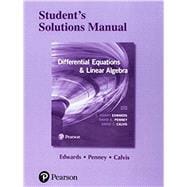For courses in Differential Equations and Linear Algebra.
This is the 18-week standalone access card for MyLab Math.
Now available with MyLab Math
The right balance between concepts, visualization, applications, and skills – now available with MyLab Math
Differential Equations and Linear Algebra provides the conceptual development and geometric visualization of a modern differential equations and linear algebra course that is essential to science and engineering students. It balances traditional manual methods with the new, computer-based methods that illuminate qualitative phenomena – a comprehensive approach that makes accessible a wider range of more realistic applications.
The book combines core topics in elementary differential equations with concepts and methods of elementary linear algebra. It starts and ends with discussions of mathematical modeling of real-world phenomena, evident in figures, examples, problems, and applications throughout.
For the first time, MyLab Math is available for this text, providing online homework with immediate feedback, the complete eText, and more. Additionally, new presentation slides created by author David Calvis are available in Beamer (LaTeX) and PDF formats. The slides are ideal for classroom lectures and student review, and combined with Calvis’ superlative instructional videos offer a level of support not found in any other Differential Equations course.
Personalize learning with MyLab Math
MyLab Math is the teaching and learning platform that empowers you to reach every student. By combining trusted author content with digital tools and a flexible platform, MyLab Math personalizes the learning experience and improves results for each student.
0136743641 / 9780136743644 MYLAB MATH DIGITAL UPDATE WITH PEARSON ETEXT -- ACCESS CARD -- FOR DIFFERENTIAL EQUATIONS AND LINEAR ALGEBRA (18 WEEKS), 4/e









